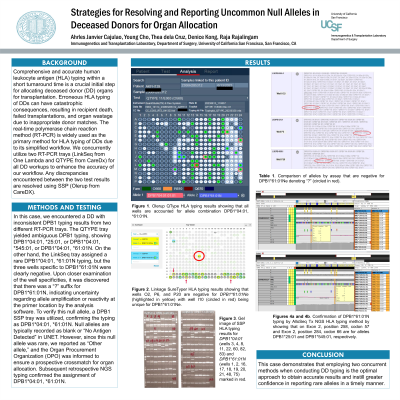Back

(P212) Strategies for resolving and reporting uncommon null alleles in deceased donors for organ allocation
Location: Platinum Ballroom

Poster Presenter(s)
Body: Comprehensive and accurate human leukocyte antigen (HLA) typing within a short turnaround time is a crucial initial step for allocating deceased donor (DD) organs for transplantation. Erroneous HLA typing of DDs can have catastrophic consequences, resulting in recipient death, failed transplantations, and organ wastage due to inappropriate donor matches. The real-time polymerase chain reaction method (RT-PCR) is widely used as the primary method for HLA typing of DDs due to its simplified workflow. We concurrently utilize two RT-PCR trays (LinkSeq from One Lambda and QTYPE from CareDx) for all DD workups to enhance the accuracy of our workflow. Any discrepancies encountered between the two test results are resolved using SSP (Olerup from CareDX).
In this case, we encountered a DD with inconsistent DPB1 typing results from two different RT-PCR trays. The QTYPE tray yielded ambiguous DPB1 typing, showing DPB1*04:01, *25:01, or DPB1*04:01, *545:01, or DPB1*04:01, *61:01N. On the other hand, the LinkSeq tray assigned a rare DPB1*04:01, *61:01N typing, but the three wells specific to DPB1*61:01N were clearly negative (Fig 1). Upon closer examination of the well specificities, it was discovered that there was a “?” suffix for DPB1*61:01N, indicating uncertainty regarding allele amplification or reactivity at the primer location by the analysis software. To verify this null allele, a DPB1 SSP tray was utilized, confirming the typing as DPB1*04:01, *61:01N. Null alleles are typically recorded as blank or “No Antigen Detected” in UNET. However, since this null allele was rare, we reported as “Other allele,” and the Organ Procurement Organization (OPO) was informed to ensure a prospective crossmatch for organ allocation. Subsequent retrospective NGS typing confirmed the assignment of DPB1*04:01, *61:01N.
Conclusion: This case demonstrates that employing two concurrent methods when conducting DD typing is the optimal approach to obtain accurate results and instill greater confidence in reporting rare alleles in a timely manner.
In this case, we encountered a DD with inconsistent DPB1 typing results from two different RT-PCR trays. The QTYPE tray yielded ambiguous DPB1 typing, showing DPB1*04:01, *25:01, or DPB1*04:01, *545:01, or DPB1*04:01, *61:01N. On the other hand, the LinkSeq tray assigned a rare DPB1*04:01, *61:01N typing, but the three wells specific to DPB1*61:01N were clearly negative (Fig 1). Upon closer examination of the well specificities, it was discovered that there was a “?” suffix for DPB1*61:01N, indicating uncertainty regarding allele amplification or reactivity at the primer location by the analysis software. To verify this null allele, a DPB1 SSP tray was utilized, confirming the typing as DPB1*04:01, *61:01N. Null alleles are typically recorded as blank or “No Antigen Detected” in UNET. However, since this null allele was rare, we reported as “Other allele,” and the Organ Procurement Organization (OPO) was informed to ensure a prospective crossmatch for organ allocation. Subsequent retrospective NGS typing confirmed the assignment of DPB1*04:01, *61:01N.
Conclusion: This case demonstrates that employing two concurrent methods when conducting DD typing is the optimal approach to obtain accurate results and instill greater confidence in reporting rare alleles in a timely manner.

